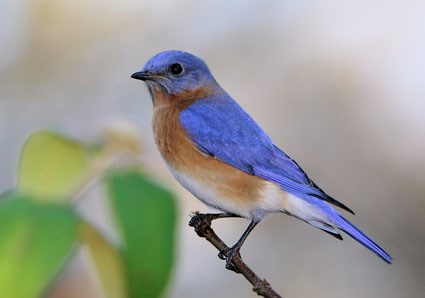
Sialia sialis
TAXONOMY
Sialia sialis Linnaeus, 1758.
OTHER COMMON NAMES
French: Merlebleu de l’est; German: Rotkehl-Hьttensбnger;
Spanish: Azulejo.
PHYSICAL CHARACTERISTICS
7.1 in (18 cm); 1.1 oz (31 g). Males have bright blue upperparts;
reddish brown chin, throat, breast, sides, and flanks; and a white
belly and undertail coverts. Females have gray upperparts; blue
wings, rump, and tail; and paler chestnut where the male is reddish
brown. Juveniles have gray-brown upperparts with white
spotting on the back, a brownish chest with white scalloping,
bluish tail and wings, and white belly and undertail coverts.
DISTRIBUTION
Eastern North America, north to Hudson Bay, west to Arizona,
south to Bermuda, Florida, and Mexico.
HABITAT
Open woodland, farmland with scattered trees, orchards, gardens
with trees and shrubberies.
BEHAVIOR
In pairs or family groups, perching upright on exposed branch
or post or tree top. Gregarious in winter, often forming large
flocks and roosting communally.
FEEDING ECOLOGY AND DIET
Feeds largely on small insects from ground, foliage, or caught
in the air; also eats fruits and berries.
REPRODUCTIVE BIOLOGY
Nests in tree hole or hollow branch, increasingly in artificial
nest boxes; nest constructed of grass, weeds, pine needles, and
twigs by the female; three to seven eggs; incubation 12–14
days; chicks fledge after 15–19 days; two or three broods.
CONSERVATION STATUS
Not threatened. Decreased by up to 90% in twentieth century
after competition for nest holes from introduced house sparrows
and starlings; increased locally after nest box provision
became popular.
SIGNIFICANCE TO HUMANS
None known.
Other popular Animals
Photo Gallery of - Eastern bluebird




 Animalia Life
Animalia Life